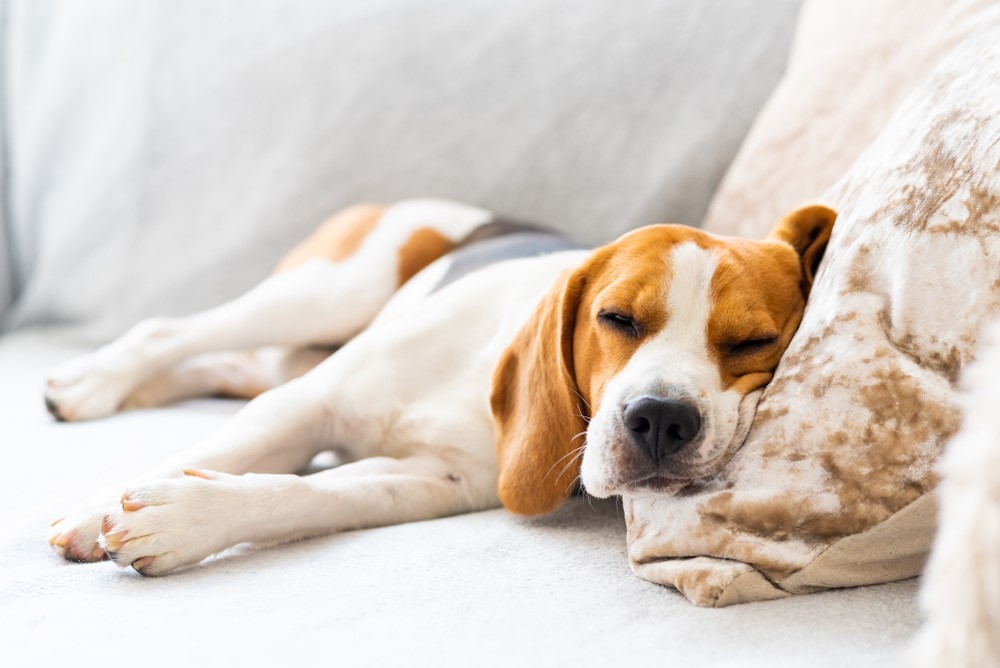Dog Twitching in Sleep? Let Them Lie – Here is Why!
Do you notice your dog twitching in sleep and moving as though they are chasing a squirrel or playing with a ball? At first glance, your dog’s unexpected motions and twitches may seem unusual or alarming. Fortunately, twitching during sleep occurs during the REM sleep cycle, which is common in both dogs and humans. These twitches happen during this sleeping stage, which is when dreams occur. This stage is also known as deep sleep, where muscle movements coincide with dreaming.
Typically, during REM sleep, the part of the brain that regulates movement is effectively switched “off” so that the muscular system remains still during this stage. Sometimes, this “switch” doesn’t fully function due to a lack of development in puppies or younger dogs and becoming weak with age in senior dogs. When the muscles are not completely switched off during REM, your pet will move, even slightly, during the dreaming stage, which results in normal twitching movements.
Why You Shouldn’t Wake Your Dog from REM Sleep
When you see your dog twitching, moaning, and moving during their sleep, it may be tempting to wake your pet and check on them. Instead of becoming concerned about your dog, sit back and enjoy the entertaining twitches and movements that mimic chasing another animal, swimming in a pool, or fetching a ball or stick in the yard.
If your dog exhibits these movements, it’s likely due to age. Young puppies and older dogs tend to twitch during sleep, and when the twitching is minimal or on occasion, they maintain significant control over the muscular system. Dogs who display continuous and restrictive motion tend to have much less control over their muscular system, as the brain’s mechanism to switch “off” doesn’t work as effectively.
There’s no reason to wake up your dog during these twitches, as there’s no risk to their health or quality of sleep. Your pup isn’t aware of these movements, as they are entranced in a deep sleep full of vivid dreams. They are likely enjoying the experience, and there’s no risk or harm done to their physical, emotional, or mental health. Most dogs will experience this type of sleeping activity during REM at some point in their lives, which is entirely natural.
Stages of Sleep
Your dog will experience all the same stages of sleep as humans, including NREM or non-rapid eye movement, SWS or short-wave sleep, and REM, rapid-eye-movement, or deep sleep. During the short-wave sleep, you’ll notice your pet begins to breathe heavily as they are moving towards a deeper stage of sleep. Once your dog reaches REM, they begin to dream. Their brain waves appear similar to humans, and based on this activity and the general nature of dogs, it’s believed they experience dreams like us.
When You Wake Your Dog
If you suspect your dog is experiencing a nightmare or may be suffering from a seizure or reacting in a way that’s concerning, you may consider waking your dog from sleep. It’s essential to determine that there are no underlying health conditions first and that no real distress is involved during their sleep. In the case of significant distress or potential medical concern, you’ll want to be careful about waking them up.
Waking up your dog too quickly from sleep can disturb and scare them. Your pup may not realize that they’re not in a dream and react wildly in response to a nightmare. It’s not unusual for a frightened, shocked dog to suddenly bite or bark loudly and unexpectedly as a result. Even if your dog is moving erratically, twitching continuously, and crying during this stage, it’s best to allow your dog to complete their entire cycle of REM sleep and wake naturally. They’ll soon forget about the dream without further incident.
Seizures, Anxiety, and Sleeping Disorders
If you notice that your dog loses control of its bowels or bodily functions during sleep, this may be due to a severe condition, including seizures. It’s crucial to contact your vet immediately to determine if any medical conditions could become more serious or impact your dog’s health.
Some dogs experience anxiety due to stress, changing circumstances in life, and other factors. When this happens, you can inquire about a mild anti-anxiety supplement or changing your pet’s diet to alleviate these symptoms and help your dog relax for bed. Dogs with epilepsy often respond successfully to treatment, preventing them from experiencing seizures, including during sleep.
Sleeping disorders, such as sleep apnea, sleepwalking, and narcolepsy may be a factor in changing sleeping patterns among some dogs. While these are rare conditions, they can impact older dogs more frequently, impacting their breathing and sleep quality.
Keeping Dogs Comfortable for Improved Sleep
If you’re concerned about the quality of your dog’s sleep, there are steps you can take to improve their comfort level:
- Speak calmly and comfort your pet before bedtime
- Provide a soft, cozy bed that makes your dog feel at ease, so they are likely to relax before sleep
- During colder seasons, it’s essential to keep your dog’s sleeping area warm, as the cooler temperature can cause your pup to twitch or tremble, trying to keep warm.
- If your dog has ample room to stretch, it may feel more comfortable and less tense during sleep.
If you keep your dog warm, comfortable and provide them with a sense of security, they are less likely to experience vivid nightmares, though there is no reason for concern if it happens. Realistically, most dogs, at some point, will twitch and move during their rest, which is perfectly natural and harmless.
Summary
When you notice your dog twitching in sleep, it’s not a cause for concern but a common reaction to the REM sleep cycle. It’s perfectly normal for most dogs and doesn’t cause any adverse effects on your pet’s health or well-being. If you notice your pet’s erratic twitches, paddling paws, and kicking motions, they’re just experiencing a vivid dream, just like many other animals and humans.

